Clontarf and Hill of Howth Tramroad Company
History
During the early 1890s, proposals were made to construct a tramway between the Dublin United Tramways Company's terminus at Dollymount, and Howth to the east, though nothing concrete happened until 1894 when a group of promoters calling themselves the Clontarf and Hill of Howth Tramways Company gained provisional approval to build a tramway between these two points, as well as an extension from Howth to the summit of the hill. Although it is doubtful whether a company of that name ever existed, the promoters no doubt found the name convenient and descriptive, so used it in official documentation.
The scheme was, however, ultimately dependent on the DUTCo for electricity, and the latter, with which the Clontarf promoters were closely associated, was in no position to provide it, as it had yet to apply for powers to convert its own horse tramway system, let alone generate electricity. The Clontarf scheme was therefore placed in abeyance until the DUTCo acquired powers to convert its lines outside the city boundary, including that to Dollymount, these not being granted until the 7th August 1896 under the Dublin United Tramways Act, 1896.
Meanwhile, the Clontarf scheme seems to have prompted the local railway operator — the Great Northern Railway Company of Ireland (GNRI) — to consider obtaining its own powers for a tramway to the Hill of Howth. The GNRI already operated railway services to Howth, and was presumably not keen on having its passenger traffic extracted by a competing electric tramway.
The two tramway applications now proceeded in parallel, the Clontarf promoters suffering a setback on the 23rd December 1896 when its modified application, which included a less severe approach to the summit, was thrown out due to objections from the GNRI, which successfully contended that the Privy Council had no authority to grant an order for a tramway between two places already connected by a railway, i.e., Sutton and Howth. The Clontarf promoters tried once again to gain approval, in 1897, this time using a different route, but this again met with the same outcome.
Meanwhile, the GNRI successfully obtained its own powers to construct a tramway from Sutton to Howth, via Summit, these being granted on the 6th August 1897, under the Great Northern Railway (Ireland) Act, 1897.
The Clontarf promoters had, however, not given up hope of reaching Howth, and despite strenuous opposition from the GNRI, successfully obtained parliamentary powers for an electric tramway between Dollymount and Howth (West and East Piers); these were granted on the 2nd August 1898, under the Clontarf and Hill of Howth Tramroad Act, 1898. The act also incorporated a company — the Clontarf and Hill of Howth Tramroad Company — to build and operate the tramway, and also included detailed arrangements for ensuring the safe working of the two tramways where they would cross on the level (at Sutton Cross).
Unlike the GNRI, the C&HofHTCo now moved quickly, the DUTCo's newly converted line from Annesley Bridge to Dollymount having opened the year before on the 11th November 1897. A contract for construction of the 5ft 3ins-gauge, overhead electric tramway was placed on the 18th March 1899, the system opening to the public 16 months later on the 26th July 1900.
The tramway was approximately 5.5 miles in length, and ran northeastwards from the DUTCo's Dollymount terminus (to the northeast of Dublin), along the north shore of Dublin Bay, through Raheny and Sutton to a terminus opposite the East Pier at Howth. It was probably unique amongst tramways in the British Isles in crossing the tracks of another tramway — the GNRI's Hill of Howth Tramway — twice, once on the level and once beneath an overbridge, though there was no physical connection between the two.
The C&HoHTCo and the DUTCo had a close working relationship, probably best evidenced by the reciprocal running arrangements — often a bone of contention between tramway operators — which were worked out years prior to construction and electrification. This was very probably due to the influence of William Martin Murphy, a businessman, tramway builder and politician; he was not only chairman of the C&HoHTCo up until its first meeting, and chairman of the Dublin United Tramways Company (from 1899 to 1919), but was also the owner of the company which built the Clontarf and Hill of Howth Tramroad and which converted the DUTCo's system to electric traction.
Tramcars initially worked through from central Dublin (Nelson Pillar) to Howth, with DUTCo crews giving way to C&HoHTCo crews at Dollymount. In 1902, however (it is not clear when, but either in February or summer), agreement was reached for the DUTCo to take over maintenance, operation and staffing of the Clontarf and Hill of Howth system, obviating the need to change crews at Dollymount. This arrangement lasted until the last day of 1906, after which the DUTCo formally leased the line for a period of 99 years, an agreement that was to have significant financial consequences for the DUTCo 40 years later.
The DUTCo decided to abandon tramway operation in 1938 in favour of motorbus operation. Whilst it was able to gradually withdraw the trams from its own system, it was effectively locked into a 99-year lease with the C&HoHTCo that was costing it £3000 per annum, on top of which it was making a loss on the services operated. The C&HoHTCo naturally held the whip hand, the DUTCo only managing to extricate itself from the arrangement on payment of a staggering 14 years of rent, i.e., £42,000. Agreement was reached on the 2nd January 1941, the last tramcar running over the Clontarf and Hill of Howth Tramroad on the 21st March 1941.
Uniforms
Photographs taken prior to the DUTCo take-over of 1902 are relatively rare, and those which show staff are rarer still; in fact, just a single example appears to have survived that can be fairly securely dated to the 1900-1902 period. Unfortunately, this photograph only reveals the most general uniform information, and a second photo, which could well have been taken in C&HoHTCo days, cannot be firmly dated, so what follows can only be regarded as tentative.
The available evidence suggests that tramwaymen wore very similar attire to their DUTCo counterparts, namely, single-breasted jackets with four buttons and lapels, along with kepi-style caps, which probably, though not certainly, carried a cap badge. Like the DUTCo, conductors were allowed to wear straw boaters in summer.
Conductors working to and from Dublin (from 1902 onwards) wore a shamrock-shaped conductor's licence issued by Dublin Police; this was invariably attached to the wearer's cash-bag strap.
From mid-1902 through to the closure of the line in 1945, staff were issued with standard DUTCo uniforms (see link).
The individual pictured on the top deck in the Howth Station photograph below is more than likely an inspector. He is wearing a single-breasted jacket with lapels and a waistcoat; like the DUTCo inspector uniforms, the collars carried insignia of some description, probably the bearer's grade. The caps carried a cap badge (of unknown pattern), and were probably in the same kepi-style favoured by the DUTCo, though given the resolution of the photograph, this cannot be stated with certainty.
Further reading
For a history of the system, see: 'The Clontarf and Hill of Howth Tramroad' by Alan T Newham, in Tramway Review No 37 (p102-121). For a history of Dublin's tramways, see: Through Streets Broad and Narrow' by Michael Corcoran; Midland Publishing (2000). For an overview of the Irish tram scene, including Dublin, see 'Irish Trams' by James Kilroy; Colourpoint Books (1996).
Images
Motormen and conductors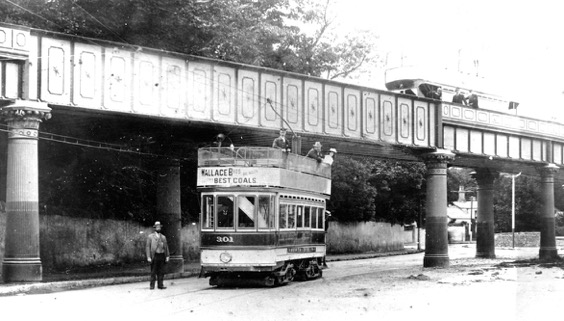
Clontarf and Hill of Howth Tramroad Company Tramcar No 301 captured beneath the tramway overbridge at Howth Station, with a Great Northern Railway of Ireland Hill of Howth tramcar (and crew) stopped on the bridge. The photo is clearly staged, and given the excellent condition of the C&HoHCo tram, it seems more than likely that it was taken shortly before, or shortly after, the opening of the GNRI's Hill of Howth line in the summer 1901, i.e., before the DUTCo took over the system. Photo courtesy of Jim Kilroy, tram archivist at the National Transport Museum.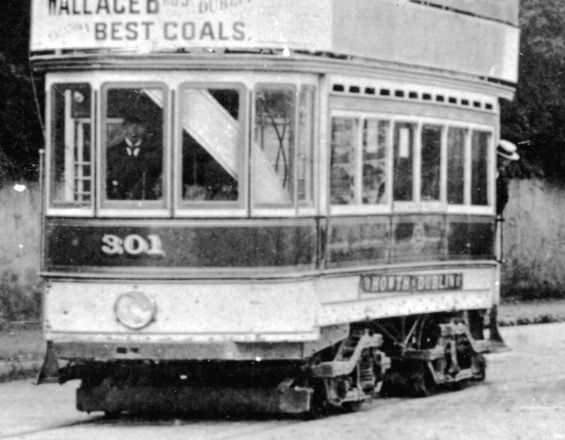
An enlargement of the above photograph showing the motorman (in the vestibule at the front of the vehicle) and the conductor (probably) on the rear platform. The motorman appears to be wearing a single-breasted jacket with lapels, and the conductor a straw boater. Other than that, this is all that can be discerned.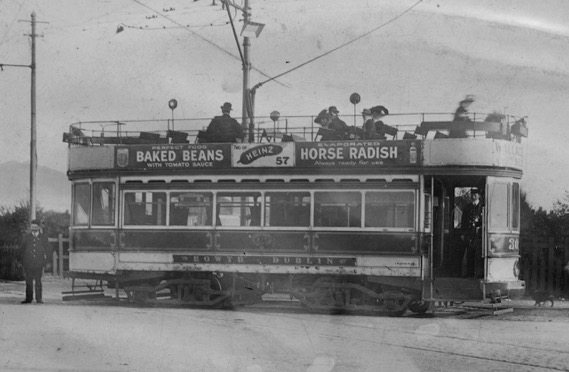
Tramcar No 307 and crew captured outside the Marine Hotel at Sutton Cross. The tram is in unmodified form (bogies and headlamp position) so the photo was almost certainly taken between 1900 and the mid-Edwardian era; it is therefore unclear whether it depicts C&HoHTCo staff before or after the DUTCo had assumed responsibility for staff and uniforms (in 1902), though the presence of Tidswell lifeguards suggests it may have been later rather than earlier. With thank to Séamus Moran, the namesake and grandson of the motorman on the left; photo courtesy of the Jim Kilroy Collection.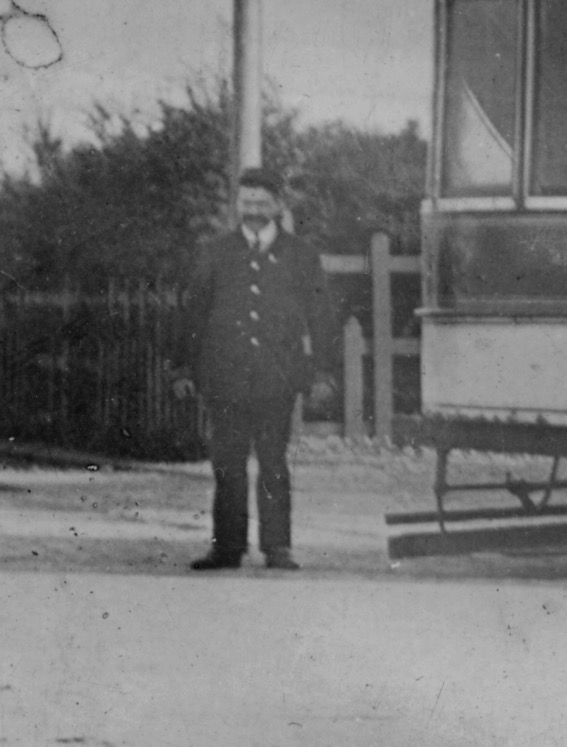
An enlargement of the above photograph showing Motorman Moran, who is wearing a uniform which is virtually identical to that issued by the DUTCo.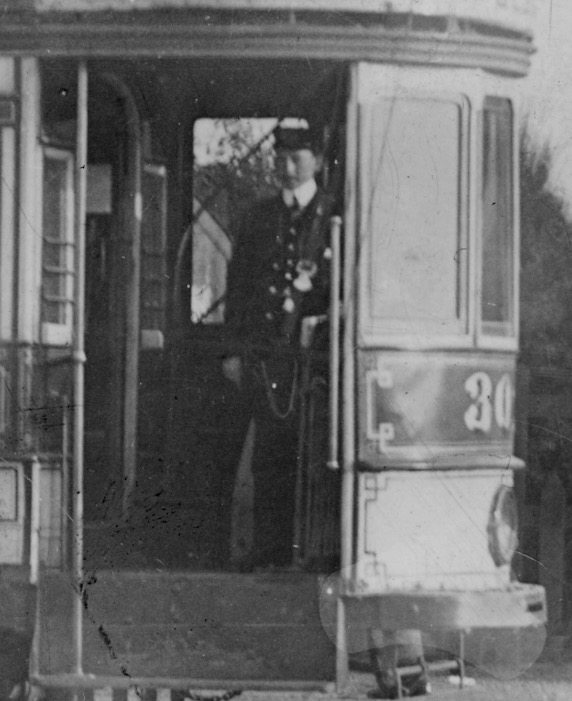
Another enlargement of the above photograph, this time of the conductor. His shamrock-shaped, Dublin Police-issued conductor's badge is attached to his cash-bag strap, strongly suggesting that the photograph was taken after staffing had been taken over by the DUTCo.
Senior staff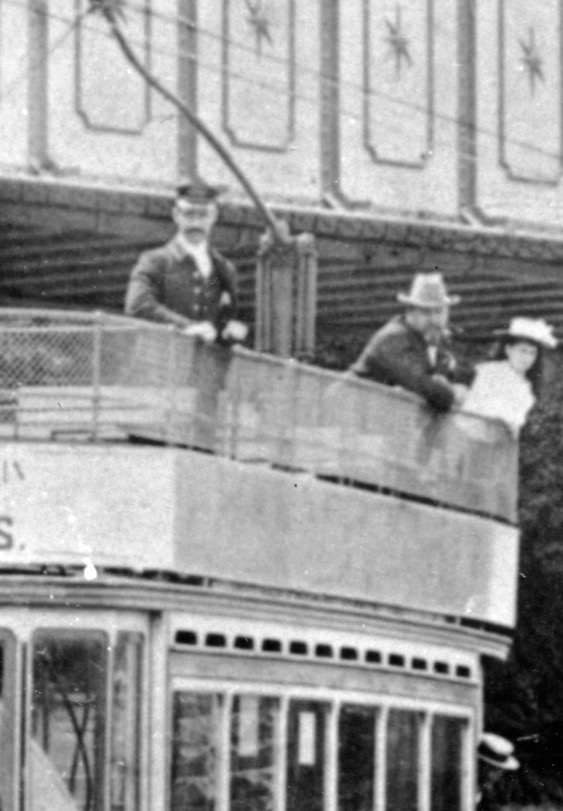
An enlargement of the Howth Station photograph above showing a uniformed individual on the top-deck, who is probably an inspector. Like the standard DUTCo inspector's uniform, the collars bear insignia. The cap carries a cap badge, though exactly what form it took is unclear. It is also unclear whether the cap is a soft-topped peaked cap or a kepi, though given the close association with the DUTCo, probably the latter.